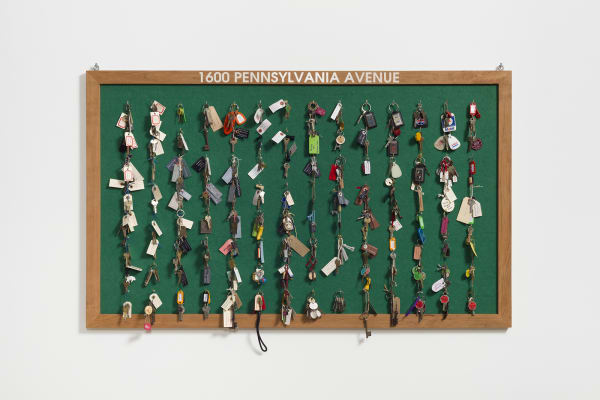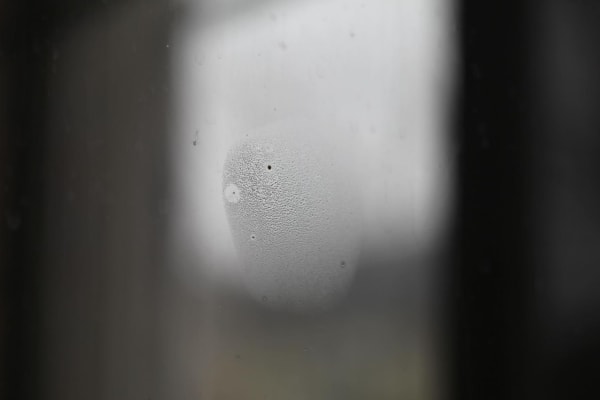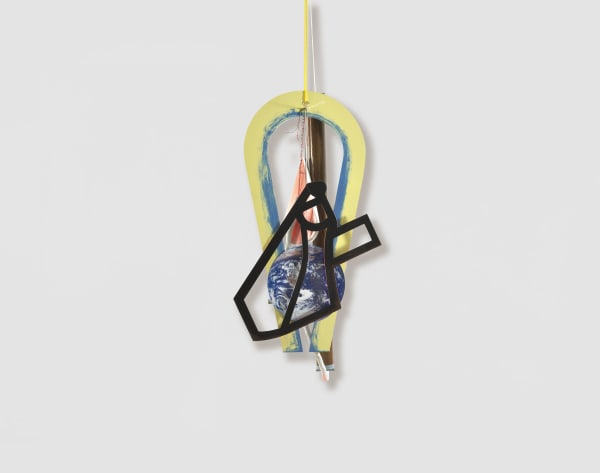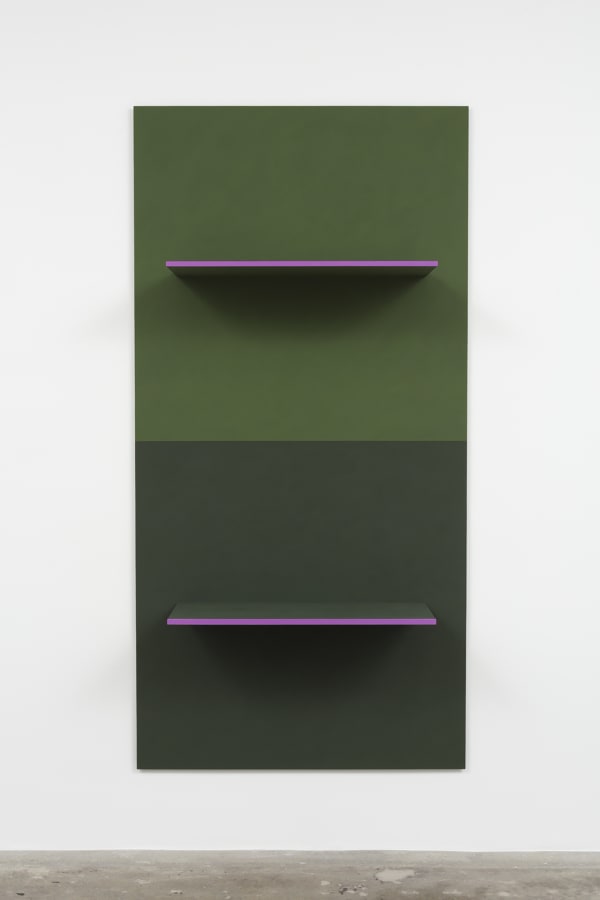

Alternating Currents continues a new series of work, beginning with Three Currents, that bridge the artist’s use of hand-blown glass and knotted rope. These works use linework in glass and rope to physicalize energy currents, which represent charged emotional currents in the world today. The latticework is made from a single length of rope that is knotted to create alternating loops that zigzag back and forth, eventually fracturing into loose ends that cascade onto the floor. A single wrapped line of white spirals around the entire body of the glass, which is also split vertically in a hemisphere of transparency and hyacinth.
Alternating Currents specifically captures the polarizing condition of today's sociopolitical climate, one of false binaries and division. In these works, named Currents, the blown volume of glass represents a lone body suspended, consumed, and drawn out by these invisible external forces. The curled tail animates the bulbous figure in a moment of fluid transformation into growth.

Kelly AKASHI
Alternating Currents
2020
Hand-blown glass, rope
18 x 9 x 9 inches; 45.7 x 22.9 x 22.9 cm (glass only)
78 1/2 x 10 x 10 inches; 199.4 x 25.4 x 25.4 cm (installed)


Throughout her career, Sandra Cinto has developed a rich vocabulary of symbols and lines to create lyrical landscapes and narratives that hover between fantasy and reality. Using drawing as her point of departure, the artist renders intricate and mesmerizing environments of turbulent seascapes, violent rainstorms, and celestial skies that frequently engage with the surrounding architecture to a disorienting effect, creating the illusion of a weightless, spiraling universe. Evoking stories of human hardship and redemption, these fantastical landscapes serve as a metaphor for the human odyssey, while also pushing the limits and possibilities of drawing.

Sandra CINTO
Untitled (from Cosmic Garden Series)
2020
Acrylic and permanent pen on canvas
49 1/4 x 68 7/8 inches; 125 x 175 cm

Sandra CINTO
Untitled
2018
permanent pen and acrylic on Japanese paper
14 1/2 x 11 x 1 1/4 inches; 36.8 x 27.9 x 3.2 cm (framed);
11 3/4 x 8 1/4 inches; 29.8 x 21 cm (unframed)


Here, a large board is filled with a precise arrangement of labeled keys. The board is crowned with the text '1600 Pennsylvania Avenue’ - spelling out the address of the White House in Washington D.C. Rather than indicating room names in the White House, the key chains of this fictional key board are a grim and humors account of presidential powers and mischief. Detailing the nefarious acts of American presidents throughout the 20th century, the key labels include references to presidential mistresses, the energy sector, policing and surveillance, nuclear deterrence, rehab centers, golf clubs, secret societies, the auto industry, Christian Right, beauty pageants among others. In its metaphorical unlocking of the secret doings of American leadership, this new work may subsequently hold the key to the American subconscious.

Mark Dion
1600 Pennsylvania Avenue
2020
Wood, felt, keys, key holder, hooks
37 7/8 x 62 1/4 inches; 96.2 x 158.1cm

Mark Dion
Untitled (Bird Feet)
2020
Colored pencil on paper
9 x 12 inches; 22.9 x 30.5 cm (unframed)


An organic arrangement of glass spheres resembles a scattered galaxy. Their placement presents no regular geometric logic, but suggests a natural formation such as the positions of the stars in the night sky. The back third of each sphere is given a mirror finish through a hand-silvering process and sealed under a layer of matte black paint. The wide angle of the mirroring allows each sphere to capture a view of the entire arrangement. Taken together, the spheres present curved reflections, each one encompassing not only the visitor but also the entire mirrored-glass system that produces her reflections.

Olafur ELIASSON
Small Galaxy composition
2020
Glass spheres, silver, paint (black), stainless steel
64 1/2 x 89 3/8 x 8 5/8 inches; 164 x 227 x 22 cm

Olafur ELIASSON
Your memory remembering
2020
Colored glass (yellow, blue, purple), driftwood
41 3/8 x 59 1/2 x 5 1/8 inches; 105 x 151 x 13 cm

Olafur ELIASSON
The glow of the void
2020
Watercolor and pencil on paper
17 1/4 x 13 1/8 inches; 44 x 33.5 cm


In Gupta’s Altered Inheritances (Last Name) series, the artist traces individuals who changed their last names either to succeed, or to survive. A linear presentation of images is layered with the reasons that names were shed, and then split in half, evoking a sharp break with the past. This work features the significant names of Albert Einstein and Muhammed Ali, among others.

Shilpa Gupta
Untitled
2014
Pigmented inkjet prints in split wood frames
40 x 200 1/2 inches; 101.6 x 509.3 cm
Edition of 3


Inspired by the ongoing forest fires and environmental destruction, Obsidian serves as a shield and protector against negativity. Created from 200 hand carved obsidian blades and a burnt walnut tree, this new sculpture embodies emotional and mental healing. The obsidian stone is known for being truth-enhancing, drawing out mental stress and tension and absorbing negative energy. Born out of lava, the strong volcanic glass is very hard and smooth but also has incredibly sharp edges. It stimulates growth, urging exploration of the unknown and opening new horizons, while also providing balance and clarity. A smokey birch scent lingers throughout the air surrounding the sculpture, suggesting the presence of nature.

Jónsi
Obsidian
2020
Obsidian, burned Brazilian walnut, resin, scent, steel
36 x 36 x 8 inches; 91.4 x 91.4 x 20.3 cm


Kurant examines how energy and capital move through the physical and the social world. Energy turns into information, and information into capital. In a world in which information is nearly free, social capital begins to play a far more significant role than financial capital, since its aggregated value can be algorithmically calculated. Just like coal, oil, gas and solar energy, social energies are now being mined, quantified and precisely valorized by algorithms, and so they became part of the global energy market.
Conversions is a liquid crystal painting the artist developed in conjunction with her residency at MIT Center for Art and Science Technologies. The work is connected to a computational, simulated “artificial society” model where ongoing data input is expressed on the surface as constantly changing colors and forms. The work relies on a custom Artificial Intelligence algorithm which parses the Twitter feeds of protest movements around the world for sentiment analysis and feeds this data to the painting. Conversions will render the current aggregated social energy, or “mood" of the protest movements at a given moment in time, ranging from happiness, enthusiasm and hope to apathy, anger and frustration. Thus, Conversions is an abstract energy landscape, a portrait of the collective intelligence of aggregated social capital, a perpetual litmus test of the current temperature of social energies.

Agnieszka KURANT
Post-Fordite 5
2020
Fossilized enamel paint, epoxy resin, iron, powdered stone
9 7/8 x 5 7/8 x 7 1/2 inches; 25 x 15 x 19 cm (sculpture)

Agnieszka KURANT
Conversions 1
2019
Liquid crystal ink on copper plate, Peltier elements, Arduino, custom programing, transistors
58 3/4 x 36 3/4 inches; 149.2 x 93.3 cm (framed)


Composition with Yellow is rendered entirely in cast bronze, yet appears to be soft clay mid-way through the process of becoming a sculpture. Juxtaposing carefully composed figurative elements alongside architectural fragments, Manders thrusts the world we know into sharp contrast and heightens our perceptual understanding. The artist gives physical form to a dreamlike psychological space where objects are often made strange by some detail, for instance subtle alterations in scale. By casting the figure in bronze, he freezes this transitional moment in time forever, highlighting a sense of fragility and timelessness simultaneously.

Mark MANDERS
Composition with Yellow
2020
Painted bronze
11 7/8 x 10 7/8 x 7 7/8 inches; 30 x 27.5 x 20 cm
Edition of 3, AP

Mark MANDERS
Composition with Yellow
2005-19
acrylic and offset print on paper, wood
50 3/8 x 60 1/4 x 2 3/4 inches; 128 x 153 x 7 cm


Drawing from biomorphism and minimalist sculpture, along with Neo-concretism and other Brazilian vanguard movements of the 1960s & ‘70s, Ernesto Neto’s work references and incorporates organic shapes and materials engaging all five senses. In this hanging sculpture, Neto continues to push the boundaries of sculpture, collapsing the boundaries between artwork and viewer, the organic and manmade.

Ernesto Neto
We are fruit, We are flower, Our heaven is, On the earth [Somos frutos, Somos flor, Nosso céu, está na terra]
2020
Cotton voile crochet, hand knotted strips and wooden ring
122 x 158 x 158 inches; 310 x 400 x 400 cm

The title of the tapestry, inspired by poet Hilda Hilst’s Poemas Malditos, Gozosos e Devotos (1984), precisely reflects the current sociopolitical context in Neuenschwander’s native Brazil, but could easily apply to most post-colonial cultures around the world: a tropical setting damned throughout history as a colony of external power; orgasmic, as the role of exotic fantasy is projected upon its people; and devoted, throughout history, to dubious organized religion and faith movements. This new series of large-scale tapestries are based on the aesthetic of 17th century Japanese erotic wood cuts and inspired by Cordel folk literature popular in the Brazilian Northeast region. Scenes of violence are depicted in vivid colors and soft curving forms. Human bodies and anthropomorphic creatures intertwine in a brutal tug and pull, where phalluses, vulvas, and other bodily features are wrestling in muddy puddles of blood.

Rivane NEUENSCHWANDER
Trópicos malditos, gozosos e devotos 15 (Tropics: Damned, Orgasmic and Devoted 15)
2020
Wool, acrylic fiber, cotton
66 7/8 x 89 3/4 inches; 170 x 228 cm


Lisa Oppenheim’s newest body of work is a series of unique silver-toned photograms titled 4:3:2. Created for her recent solo exhibition at the gallery’s Los Angeles location, the artist used archival image sources and related material filters to explore the impact of celluloid roll film on the film and photographic industries. Featuring no image, these tiled photograms are the result of an experimental process of varied exposure to light and chemical wash. Each work features subtle variations of texture and tone with a metallic sheen, making oblique reference to the “silver screen” which continues to define the way we think of cinema, far into the digital age. As referenced in the series’ title, the proportions of the individual panels and overall dimensions of each work conform to the aspect ratio of early still images and silent motion picture film.

Lisa Oppenheim
4:3:2 (Version XV)
2020
Tiled silver gelatin photograms
30 3/8 x 40 1/8 x 1 1/2 inches; 77.2 x 101.9 x 3.8 cm

Lisa Oppenheim
Landscape Portraits (Camphor) (Version V)
2020
Tiled silver gelatin photograms in Camphor frames
22 x 22 inches; 56 x 56 cm (unframed)
22 5/8 x 22 5/8 x 1 3/8 inches; 57.5 x 57.5 x 3.5 cm (framed)

Lisa Oppenheim
Remnant (Garland)
2017
c-print
39 5/8 x 55 1/4 inches; 100.6 x 140.3 cm (overall)
36 1/8 x 27 1/8 inches; 91.8 x 68.9 cm (each panel framed)
Edition of 1, 1 AP

Taking inspiration from a lullaby in Roman Polanski's Rosemary’s Baby (1968) and
intertwining sleep with death, these seemingly soothing songs often have dual meanings
and are laced with disturbing lyrics. The sounds are contained within each of the barrels
and the sense of distance and isolation is palpable. Emanating from stainless steel barrels,
the sculptural acoustics suggest deep space, distance and memory. The voice recordings
are accompanied by a percussion beat set to the rhythm of the artist’s heartbeat, acting as
a metronome for the lullaby.

Susan PHILIPSZ
Sleep Close and Fast (Rosemary's Baby)
2020
Two-channel sound installation, 55 gallon and 30 gallon steel oil drums, speakers, amplifier, media player
Duration: 2 min, 26 sec
28 x 19 x 19 inches; 71.1 x 48.3 x 48.3cm Overall dimensions variable
1 barrel dims: 35 1/4 x 23 1/2 x 23 1/2 inches; 89.5 x 59.7 x 59.7 cm
1 barrel, dims: 28 x 19 x 19 inches; 71.1 x 48.3 x 48.3 cm
Edition of 3, 2AP

Susan PHILIPSZ
Vernebelt I
2016
Chromogenic print mounted on Aludibond behind glass
12 7/8 x 19 5/8 inches; 32.7 x 49.8 cm
Edition of 3, 2 APs


Saraceno has long included arachnology as a tool for the investigation of alternative constructions. For Saraceno, spider webs spark inquiry into possible modes of redefining relationships between humans and nature, proposing utopian conditions for sustainable societies. Formed of suspended complex interwoven geometries, each piece appears as a unique galaxy floating within an expansive landscape. The work’s title reveals the technical basis for each sculptural element; such as the genus and species of the spider collaborators and the amount of time spent constructing their webs.

Tomás SARACENO
Hybrid Dark semi-social Cluster SAO 208102 built by: an ensemble of Cyrtophora citricola - four weeks, rotated 180°
2020
Spidersilk, carbon frame, glass, ink, metal
15 5/8 x 21 5/8 x 15 3/4 inches; 39.6 x 55 x 40.1 cm

Tomás SARACENO
SB84/P15
2019
stainless steel, metal wire, mirror panels
approx. 23 5/8 x 23 5/8 x 23 5/8 inches; 60 x 60 x 60 cm

Tomás SARACENO
Aeolus 13.8
2019
Mirrored hand-blown glass, metal structure
9 7/8 x 17 3/4 x 9 7/8 inches; 25 x 45 x 25 cm


Culminating fundamental methods and concepts from her practice, Saban’s new Pleated Ink works use elements and processes that have continued throughout her career - the precision of laser cut paper, ripples created by printers ink, the rigid and mechanical forms of circuit board - these works bring together essential components of Saban’s oeuvre. Playfully undermining the relationship between form and function, each pattern echoes the geometric pattern of a specific circuit board that has played a significant role in the history of computer technology. Following the same binary logic as the loom, Saban’s new Pleated Ink series is created by a laser cutting machine cuts a sheet of paper in the precise pattern of a computer chip. Saban then presses the paper onto a wooden panel covered in a pool of printer ink. As a result, the ink forms lines and crevices along the exact pattern of particular computer chips, which are referenced in each title. These works are imbued with the imaginary depths of information carried on the filigree channels and wires of the microchips.

Analia Saban
Pleated Ink Circuit Board #15
2019
Ink and laser carved paper on wood panel
30 x 40 inches; 76.2 x 101.6 cm

Analia Saban
Woven Diagonal Gradient as Weft (Top-left Corner to Bottom-right Corner, White) #2
2019
Woven acrylic paint and linen thread
69 3/4 x 70 inches; 177.2 x 177.8 cm


In a figurative sense, an image is always a reservoir for information, thoughts and experiences. The term Speicher appears throughout Scheibitz' oeuvre and here is partnered with a number indicateing this is the artist's 1072nd painting.
This painting and the following sculpture will be featured in his upcoming solo exhibition at Tanya Bonakdar Gallery, New York opening on October 29, 2020.

Thomas SCHEIBITZ
Speicher 1072
2020
Oil, vinyl and pigment marker on canvas
94 1/2 x 67 x 2 inches; 240 x 170 x 5 cm

Thomas SCHEIBITZ
Magnet
2020
mixed media
82 5/8 x 37 3/8 x 11 7/8 inches; 210 x 95 x 30 cm


For over 20 years, the artist has developed this series that presents an object, unadulterated and isolated, yet framed in a way to allow the viewer to consider the ambiguity of one object's meaning. Framed as a precious cultural artifact, the found objects are stripped of their definition as commercial, or antique, or functional devices, etc. Instead, in Minimalist fashion they are open to boundless subjective interpretation. These new associations could be related to form and design, art historical reference, sociology or psychology, and are inevitably influenced by cultural and personal contexts and histories. This display of singular objects in a protected case, as opposed to his other works that arrange objects on an exposed shelf, continues a thread that runs throughout his entire practice: calling attention to the common rituals of collecting, framing, and presenting objects, and within this re-contextualization, touching on our aspirations and values in relation to the objects of our modern world.
Engaging our curiosity is Untitled (candle), which plays upon ideas of representation and contingency with an object whose state can shift between liquid and solid. Isolated and presented on a glass shelf inside the enclosed case, certain aspects of the object are activated and transformed in ways that might not occur if it seen in our everyday space. For example, in this context the volume of the wax figure is heightened, and a corporeal quality is apparent.

Haim STEINBACH
Untitled (candle)
2015
Baltic Birch plywood, plastic laminate
and glass box; "tree trunk" wax candle
37 7/8 x 52 3/8 x 23 1/2 inches; 96.2 x 133 x 59.7 cm

Haim STEINBACH
pantonecaribbeansea18-4525
2016
Vinyl text, acrylic paint
Dimensions variable
Edition of 2


Regarded for his works on paper, Dirk Stewen has developed a rich and varied practice that incorporates aspects of photography, drawing, assemblage, collage, and embroidery. Drawing from his own collection of images, the artist presents unexpected yet poignant juxtapositions of forms, materials and ideas that suggest new associations and narratives. Faded photographs, watercolors, confetti and thread are among the many materials Stewen has recombined into poetic compositions that are at once visually arresting and charged with emotion.

Dirk STEWEN
Wandlung (Studie für Daphne)
2020
Paper collage
Ink, inkjet prints, offset print, graphite on paper
78 3/8 x 54 3/4 inches; 199 x 139 cm

Dirk STEWEN
Untitled (public phone, PCH)
2020
Ink and inkjet prints on paper
39 1/8 x 27 3/8 inches; 99.5 x 69.5 cm


Through complex constellations of objects and a proliferation of images, Sze expands upon the never-ending stream of visual narratives that we negotiate daily, from magazines and newspapers, television and iPhones, to cyberspace and outer space. This work evokes the generative and recursive process of image-making in a world where consumption and production are more interdependent, where the beginning of one idea is the ending of another—and where sculpture gives rise to images, and images to sculpture. Sze expands her work by embedding her nuanced sculptural language into the material surfaces of a painting and into the digital realm through the interplay of cloth, ink, wood, paper, metal, paint, found objects, light, sound and structural supports—collapsing distinctions between two, three and four dimensions. Her practice fundamentally alters our sense of time, place, and memory by transforming our experiences of the physical world around us.

Sarah Sze
Dial Twice
2020
Oil paint, acrylic paint, acrylic polymers, ink, aluminum, archival paper, diabond and wood
16 x 20 x 1 1/2 inches


Dishwashing Sculpture #14 is part of an ongoing series by Wermers of adapted ready-mades that play with degrees of function and misappropriation in the domestic environment. In precarious assemblages of pots, porcelain and kitchen devices stacked as if to dry, architectural ambition and daring statics form a contrast to female reproductive labour.

NICOLE WERMERS
Abwaschskulptur (Dishwashing Sculpture) #14
2020
Various china, ceramic, kitchen utensils, modified dishwasher basket, plinth
81 7/8 x 35 3/8 x 33 1/2 inches; 208 x 90 x 85 cm


Lisa Williamson’s Body Board (Landscape) (2020) offers a reduced representation of space on a dichromatic field of green. Extrusions projecting off the surface further disrupt pictorial depth, prompting a restless classification between painting and relief. Body Board (Landscape) is currently included in Restless Index, a gorup exhibition at Tanya Bonkdar Gallery, Los Angeles curated by Kelly Akashi and Cayteano Ferrer.

Lisa Williamson
Body Board (Landscape)
2020
Flashe, microbeads on powder-coat primed aluminum
80 x 40 x 12 3/4 inches; 203.2 x 101.6 x 32.4cm

Lisa Williamson
Ink Band Bend
2016
Flashe on powder-coat primed aluminum
59 1/2 x 16 x 4 1/2 inches; 151.1 x 40.6 x 11.4 cm